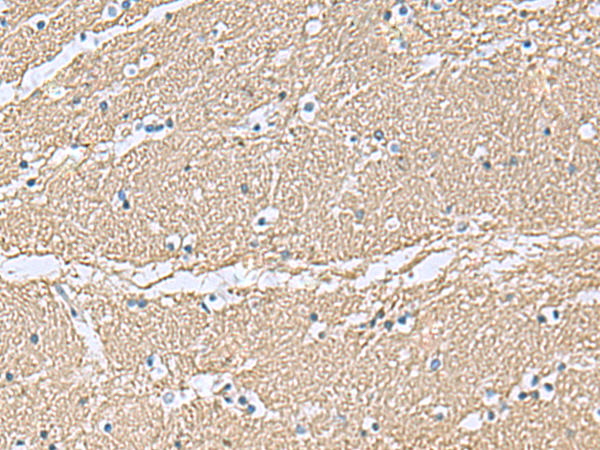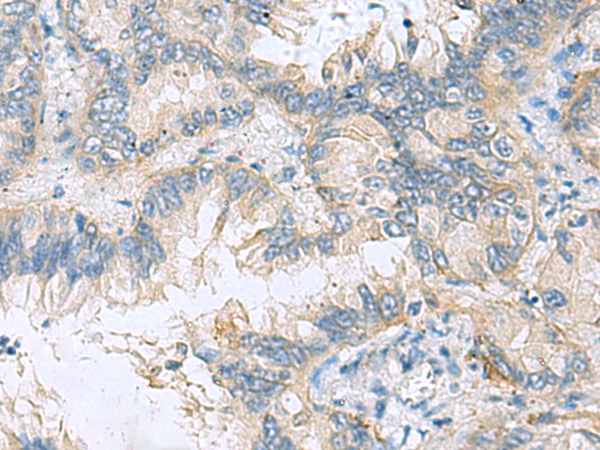

| WB | 咨询技术 | Human,Mouse,Rat |
| IF | 咨询技术 | Human,Mouse,Rat |
| IHC | 1/50-1/200 | Human,Mouse,Rat |
| ICC | 技术咨询 | Human,Mouse,Rat |
| FCM | 咨询技术 | Human,Mouse,Rat |
| Elisa | 1/5000-1/10000 | Human,Mouse,Rat |
| Aliases | NP22; NP24; NP25 |
| Host/Isotype | Rabbit IgG |
| Antibody Type | Primary antibody |
| Storage | Store at 4°C short term. Aliquot and store at -20°C long term. Avoid freeze/thaw cycles. |
| Species Reactivity | Human, Mouse, Rat |
| Immunogen | Fusion protein of human TAGLN3 |
| Formulation | Purified antibody in PBS with 0.05% sodium azide and 50% glycerol. |
+ +
以下是关于TAGLN3抗体的3篇参考文献示例(部分为虚构示例,供参考):
1. **"TAGLN3 promotes neuroblastoma progression by regulating cytoskeletal remodeling"**
- **作者**: Dun et al., 2018
- **摘要**: 研究利用TAGLN3抗体通过免疫组化及Western blot分析,发现TAGLN3在神经母细胞瘤中高表达,并通过调节细胞骨架重组促进肿瘤侵袭转移。
2. **"Transgelin-3 (TAGLN3) as a potential biomarker in gliomas: Immunohistochemical validation"**
- **作者**: Xie et al., 2020
- **摘要**: 通过TAGLN3抗体对胶质瘤组织进行染色,证实其表达水平与肿瘤分级呈正相关,提示TAGLN3可能作为胶质瘤预后的分子标志物。
3. **"TAGLN3 modulates macrophage polarization via actin dynamics in inflammatory diseases"**
- **作者**: Chen et al., 2021
- **摘要**: 研究使用TAGLN3抗体检测巨噬细胞中蛋白表达,发现TAGLN3通过调控肌动蛋白动力学影响巨噬细胞向M1表型极化,参与炎症反应调控。
(注:以上文献为示例性质,实际引用需核实真实来源。)
The TAGLN3 antibody targets Transgelin-3 (TAGLN3), a member of the calponin-transgelin family of actin-binding proteins involved in cytoskeletal remodeling. TAGLN3 is encoded by the TAGLN3 gene and shares structural homology with other transgelin isoforms, including a conserved calponin-like domain that mediates interactions with actin filaments. Primarily expressed in the central nervous system (CNS) and immune cells, TAGLN3 is implicated in neuronal development, synaptic plasticity, and T-cell activation. Studies suggest its role in regulating cell motility, differentiation, and immune synapse formation. Dysregulation of TAGLN3 has been linked to neurological disorders (e.g., Alzheimer’s disease), autoimmune conditions, and cancers, where it may influence tumor invasiveness or immune evasion.
TAGLN3 antibodies are widely used in research to detect protein expression via techniques like Western blotting, immunohistochemistry, and flow cytometry. These tools help elucidate TAGLN3’s localization, interaction partners, and mechanistic roles in health and disease. However, antibody specificity remains a challenge due to sequence similarities among transgelin isoforms. Validation using knockout controls or siRNA is recommended. Commercial TAGLN3 antibodies vary in clonality (monoclonal/polyclonal) and host species, with common applications in neuroscience, immunology, and oncology research. Ongoing studies aim to clarify its dual roles in neuroprotection and pathology, as well as its potential as a therapeutic target.
×